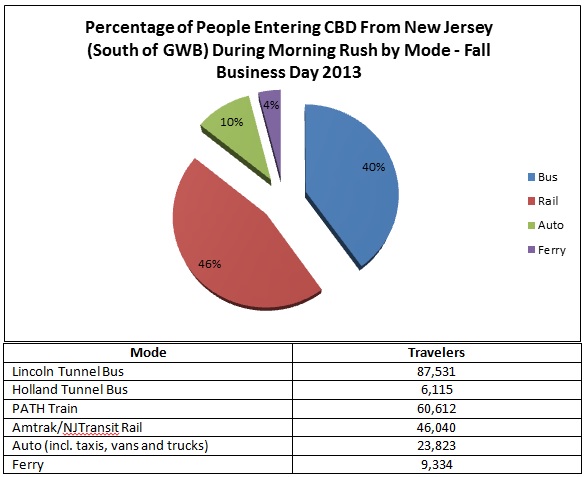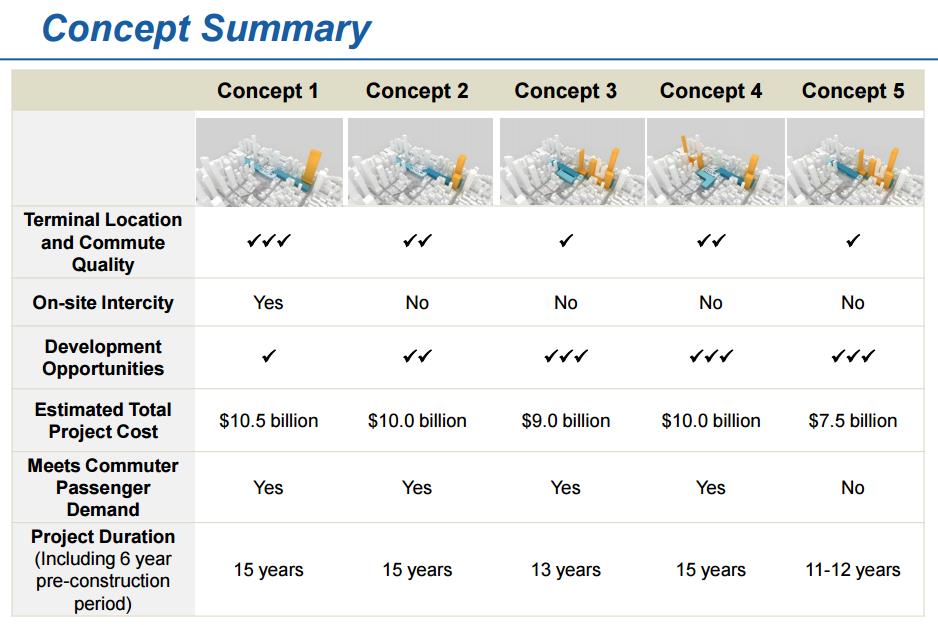Last week the Port Authority of New York and New Jersey released preliminary proposals for a new bus terminal. There were five proposals in total, estimated to take anywhere from 11 to 15 years to complete, with some estimated to cost as much as $10.5 billion. And while it’s very encouraging to see the Port Authority finally acknowledge the bus terminal’s real long-term needs, a new terminal is not a slam-dunk solution to the cross-Hudson capacity dilemma. There has been a serious dearth of vision for managing cross-Hudson capacity, which is poised to become a true crisis for all public transit modes if solutions and funding are not prioritized.
Port Authority Bus Terminal (PABT)
The PABT was built in 1950 at a cost of $24 million (approximately $233 million in today’s dollars), but quickly reached operating capacity by 1966, necessitating subsequent expansions. Today, the terminal is again operating above capacity, handling over 230,000 riders per day, with demand projected to grow to 330,000 by 2040. This is not a new issue. In fact, Tri-State has been sounding the alarm about cross-Hudson bus capacity since last decade.
PATH Train
Riding trains across the Hudson is also an increasingly daunting experience. Jump on any rush hour PATH train and you are sure to be far from alone. PATH ridership stands at roughly 250,000 passengers per day, an increase of nearly 50,000 passengers per day since 1994, and with even more development slated for Hoboken and Jersey City planned or under construction, capacity is and will continue to be a real problem.
NJTransit/Amtrak
The other cross-Hudson commuter issue is tunnel capacity for NJTransit and Amtrak. The North River Tunnels, which carry 359 NJTransit and 100 Amtrak trains every day, are at capacity. With the cancellation of ARC in 2010, the only current plan on the horizon is Gateway, with a potential completion date of 2025.
The Port Authority needs to better address the urgency of these cross-Hudson capacity problems, especially since 86 percent of people entering Manhattan during rush hour use these modes (bus, PATH and commuter rail). It was only after significant advocacy that the Port Authority found another $90 million in its 2014-2023 capital program for Quality of Commute improvements, despite the need for a new bus terminal having been discussed for more than a decade.

Given the commuting breakdowns between modes, cross-Hudson capacity must be improved in the short term and increased in the medium/long term because public transit is by far the preferred mode of travel between New York and New Jersey. Forcing even just a small number of these public transit riders into cars would grind the delicate and fragile transit weave to a halt. The Port Authority must embrace its mission of “undertak[ing] port and regional improvements not likely to be financed by private enterprise, or that would not be attempted by either state alone” to combat these problems.
A new PABT is a good start. It was surprising to see new estimates 10 times greater, given that previous estimates as recently as last year approximated a cost of $800 million. The Port Authority must bring down costs and get the project going; the capacity constraints at the obsolete terminal and the longstanding awareness of the problems ahead necessitate that the Port Authority make this a top priority now.
One way to jumpstart this terminal is to shift the $1.5 billion earmarked for a PATH extension to Newark Airport—a redundant project that would not serve to increase capacity. Capacity projects like the PABT and Gateway, and improvements to the PATH, should be the Port Authority’s major infrastructure investments in its current capital program, and these investments should be on par with others. Aviation comprises 29.1 percent of the capital program, while, PATH (without the proposed extension) comprises 7.8 percent; the PABT, a paltry 0.63 percent.


Dedicating one lane each way in the Lincoln Tunnel to buses at least 18 hours a day could improve the flow in the terminal. The exclusive bus lane should be extended as far as needed.
[…] TSTC Suggests Better Ways for Port Authority to Spend $1.5 Billion Than PATH to Newark Airport […]
The idea of NOT building the bus terminal in Manhattan but instead extending the 7 subway line to Secaucus and a bus terminal in New Jersey makes a lot of sense. It appears to be getting some traction.
A lot more people can go on Rails than buses which is a major reason why Bus Rapid Transit is a bad idea. Moreover subways are electrified and thus can be powered by renewable electricity rather than oil which will begin declining again shortly as shale oil production shuts down.
The George Washington bridge was built to run trains on the lower level.
We should be doing that after finally extending the Hudson Bergen Light Rail without striking distance of the GWB.
This leverages the existing bridge without requiring another gargantuan multibillion dollar 10 year project. It is simply an issue of making the connection points on the NJ and Manhattan sides of the GWB…
Not cheap either but a lot easier than new tunnels or bridges…
Someone should please do the math, but I suspect that easily the biggest bang for the buck (increased passenger count per dollar spent) would come from doubling the capacity of the PABT, dedicating TWO lanes of traffic through the Lincoln Tunnel during rush-hours to buses, increasing bus-size (capacity), smoothing the flow of ALL buses between the Tunnel and the Terminal, and reducing the flow of non-bus vehicles through the Tunnel by a prohibitive increase in the toll.
[…] the Region recently explored the current and future capacity problems confronting trans-Hudson commuters and why the Port Authority Bus Terminal should be one of the […]
@Dick Colby
No. The price tag just to replace the aging PABT is nearly $10 billion! The Lincoln Tunnel is already at or exceeding capacity, especially during rush hour. Travel times to traverse the tunnel will continue to increase as the situation deteriorates further due to growth. The other major issue is idling buses awaiting the afternoon rush from Manhattan. It’s already a major operational challenge at current capacity, to find spaces for all these buses, let alone accounting for future growth that will occur.
A new terminal in Secaucus Junction, or elsewhere near Manhattan, along with a rail connection, would be less costly than rebuilding in Manhattan and could be funded by the proceeds from selling off two prime city blocks next to Times Square for redevelopment. That’s the direction we’re heading as it provides provides new trans-hudson capacity, grows ridership, and overall provides the most bang for the buck.
Extending the 7 line to a new PABT at Secaucus Junction will require several state agencies from New York and New Jersey to work together, but it’s the best, cost-effective solution for inter-regional mobility.
[…] passengers a day, not including jitneys and airport buses that board outside, but this is expected to rise to 340,000 by […]
[…] the Port Authority Bus Terminal needs to be replaced, and it’s projected to cost about $10 billion […]
[…] Ny coach capability. With increased vehicles entering Ny, along with a Slot Authority Bus Final at capability since 1966, there will be a have to reshuffle the way in which vehicles get and fall off guests within the […]
[…] $15 million is allocated for a design competition for the new PABT. […]
[…] or approximately 230,000 cross-Hudson passengers per weekday. In terms of volume, it is the most critical node in the cross-Hudson peak-hour commute. But because of planning delay, it’s now operating above capacity, meaning not only are […]